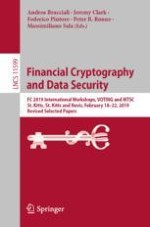This book constitutes the refereed proceedings of two workshops held at the 23rd International Conference on Financial Cryptography and Data Security, FC 2019, in St. Kitts, St. Kitts and Nevis, in February 2019.The 20 full papers and 4 short papers presented in this book were carefully reviewed and selected from 34 submissions.The papers feature the outcome of the 4th Workshop on Advances in Secure Electronic Voting, VOTING 2019 and the Third Workshop on Trusted Smart Contracts, WTSC 2019. VOTING covered topics like election auditing, voting system efficiency, voting system usability, and new technical designs for cryptographic protocols for voting systems.WTSC focuses on smart contracts, i.e., self-enforcing agreements in the form of executable programs, and other decentralized applications that are deployed to and run on top of (specialized) blockchains.
